This post may contain affiliate links. If you use these links to buy something we may earn a commission. Thanks.
If you’ve been wishing for shade but haven’t found what’s best to plant, a beautiful fast-growing, and long-living tree will not only cast shade but increase your privacy and break strong winds.
The best shade tree grows fast, lives long, gives shade (to be clear!), serves you in more than one way, and is suitable to your climate and your property.
In general, Sycamore, Maple, Hackberry, Northern Catalpa, Kentucky Coffee, and Tulip trees are the fastest-growing shade-giving trees for Zones 5 to 8. Each tree type comes in numerous varieties, and some of which are more or less preferable for your shade needs.
The best choice for you could depend on looks, secondary uses, size expectancy, or more.
Each shade tree has a different mature height and spread, requires more or less maintenance, is uniquely useful, prefers various soils, and grows better or worse in certain areas.
You’ll find the best shade tree for your situation as we share all these vital aspects for each tree choice.
And no matter what you choose from these options, you’ll have shade in a few short years and for the rest of your time.
Related: Best Zone 4 Ground Covers for Shade (with Pics)
Disclaimer: Food Forest Living or its authors are not responsible for what you choose to consume. Do your own research before consuming as an “edible” or using any herb for medicine. Before planting any of these options check with your local invasive plant council or regional extension office for guidance on plants that may be invasive in your area.
Best Sycamore Trees for Giving Shade
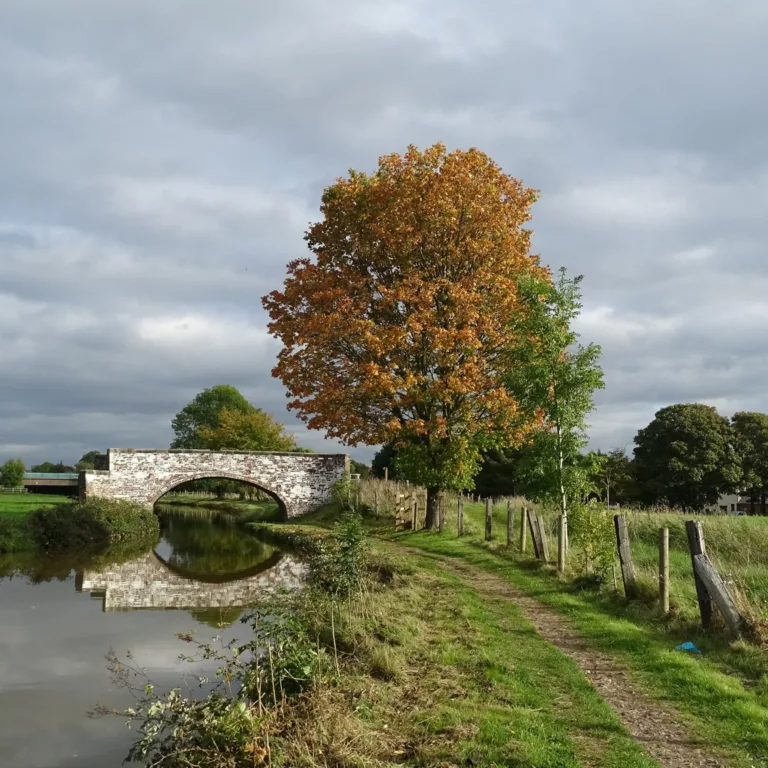
Grow zones 4-9
The American Sycamore tree (Planatus occidentalis) is among the largest of hardwoods in America. They are known for growing large and wide with broad leaves. In no time, you’ll lower your energy bill as they grow 2-6 feet per year and the average 2-story home is only 18-20 feet tall.
All Sycamore species (Planatus spp.) are used for shade, carbon sequestration, and habitat.
Their leaves take a little longer than average to fully unfurl, so you’ll enjoy the dappled shade in the cool-tempered spring, and full shade when the heat hits in late May or June.
When the leaves are fully grown, you’ll get dense shade.
The best sycamore trees for shade include:
- American Sycamore (Platanus occidentalis)
- Oriental Plane Tree (Platanus orientalis)
- London Plant Tree (Platanus x acerifolia)
The right sycamore tree for you could depend on what your area is like and what you want.
The American Sycamore is native to North America and specializes in shading hot summers. It grows to 75 to 100 feet (or more) and spreads 40-70 feet (or more) in time. They grow particularly fast in their early years, so you won’t have to wait too long for results.
In general, American Sycamores are low-maintenance trees. Mulch the base properly when first planted, prune as needed to encourage a healthy structure and prevent any rubbing branches, and remove any dead or diseased branches as they appear.
American Sycamores are also adaptable trees to various conditions. They prefer rich, loamy, and moist soils but tolerate most other soil types including clay, sand, and silt, even with some gravel mixed in, if there happens to be.
Wet and somewhat waterlogged soils are easily tolerated by American Sycamores as they prefer moisture in general. Well-drained moist soil is ideal.
The Oriental Plane Tree is native to parts of Europe and Asia. These trees are more resilient in harsh urban settings from poor soil to general pollution.
Oriental Plane Trees have different bark characteristics and coloring compared to the American Sycamore, but both are beautiful. American Sycamore tends to have puzzle pieces of browns, whites, and grays. Oriental Plane tends to have smoother greens and browns.
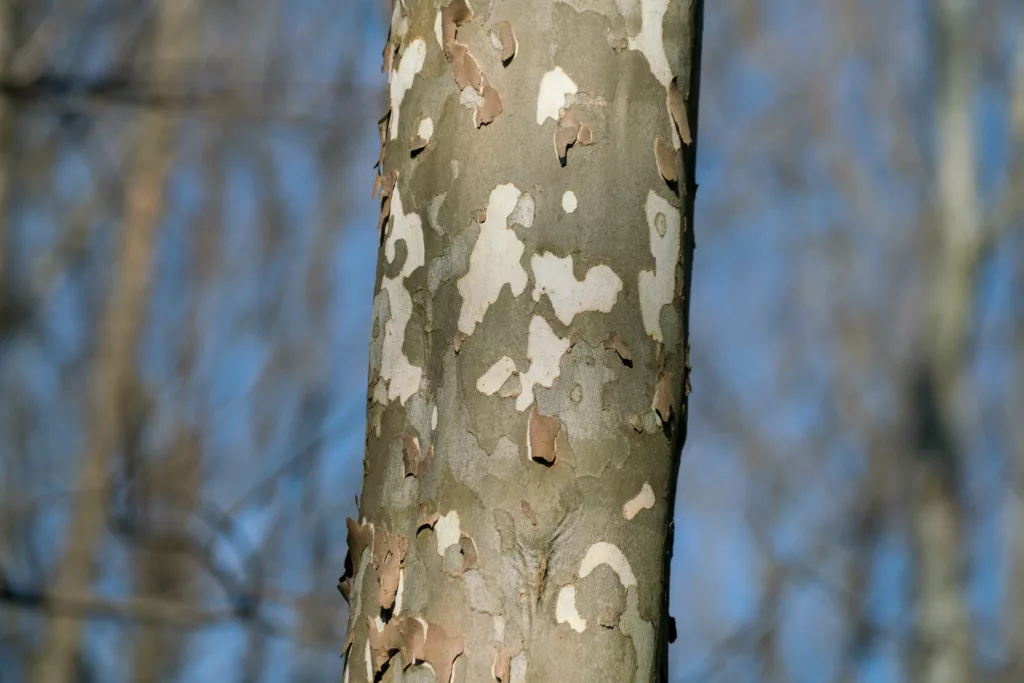

Well-drained moist soils are also ideal for the Oriental Plane tree, however, they are less tolerant to waterlogging and more tolerant to droughts if compared with the American Sycamore.
The London Plane Tree is a hybrid between the American Sycamore and Oriental Plane Tree. The outer bark is smoother than American Sycamore.

Sycamores (Planatus), in general, are very similar in characteristics, growth habits, and purposes, but are best selected based on their native range or property conditions.
How to choose the right sycamore tree?
If you live in America and have a dry or drought-prone area for your tree to the extent you think it’s too dry for a moisture-loving American Sycamore, just remember that when the tree eventually casts dense shade, little water will be evaporated from the area.
If you don’t think the shade will make a difference in dry conditions, then the London Plane Tree hybrid may be a better choice.
If you value natives and live in America then the Native American Sycamore will likely thrive after established, even if it’s on the dry side. Just be sure to water as needed while young and unestablished.
Any Sycamore tree is best suited for a very spacious area. It’s recommended not to plant them within 15 feet of any foundation. But personally, for longevity’s sake, I would give it 25 feet at minimum, if you have the space.
Best Maple Trees for Giving Shade
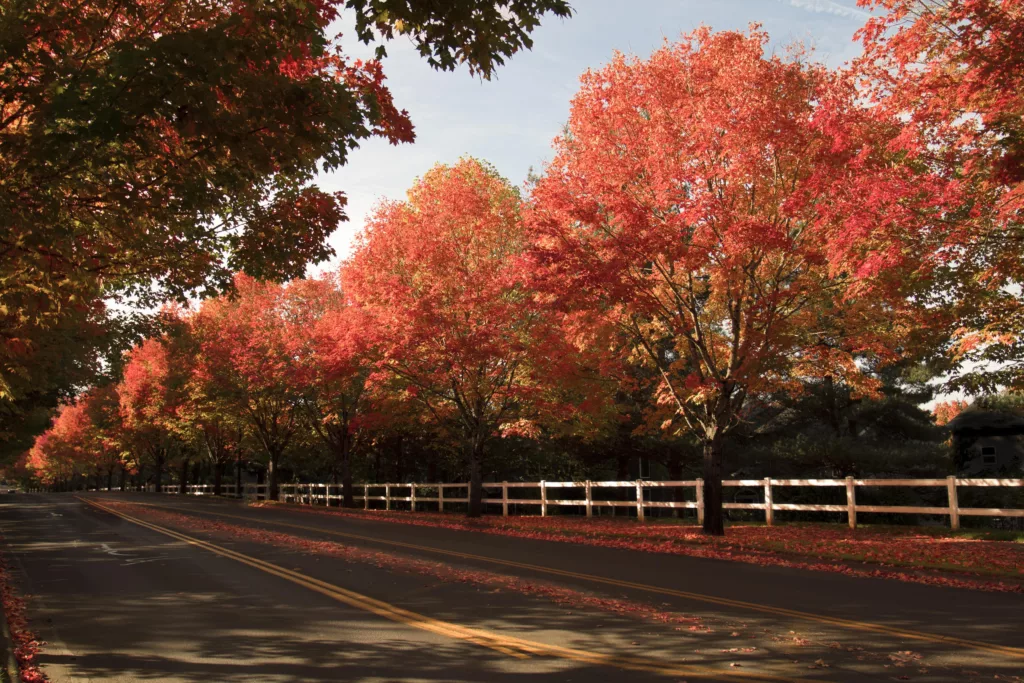
Grow zones 4-9
Maples are not only known for stunning fall foliage but for providing shade. Their canopies tend to spread wide and their leaves offer varying degrees of shade density between species.
Sugar Maple, Silver Maple, Red Maple, Freeman Maple, and Norway Maple are some of the best maple tree varieties for giving shade. Some grow faster than others, provide more dense or dappled shade, and are more or less suitable for the characteristics of the planting site.
You can also tap any of these maple trees to make syrup from sap! Sugar maples are most often used for syrup-making due to their high sap sugar content.
How to choose the right maple tree for you? Let’s compare them!
But caution: avoid calling it a day by comparing shade intensity and nothing else, because your shade preference doesn’t make it the best (safest) tree for your site.
Below, I’ve compared shade intensity, growth rates, environmental preferences, fall coloring, and suitable settings, and other uses.
Each maple tree has a different canopy habit which changes the shade intensity and coverage circumference.
‘Spreading’ canopies tend to grow in varying directions creating an asymmetrical shape. ‘Rounded’ canopies tend to grow upward and outward with symmetry, resulting in a compact round shape. ‘Broadly rounded’ is a mix between the two, a big rounded with plenty of widths too.
| Canopy Habit | Shade Intensity | |
| Sugar Maple | Spreading | Wide & Dense |
| Silver Maple | Wide-spreading | Wide & Moderate |
| Red Maple | Rounded | Moderate |
| Freeman Maple | Broadly Rounded | Wide & Dense |
| Norway Maple | Rounded | Dense |
The growth rate will change the length of time you’ll need to wait before you can sit in the shade of the tree.
Considering the environmental preferences will make growing a tree easier by choosing a suitable match for your planting site.
| Growth Rate | Environmental Preferences | |
| Sugar Maple | Moderate | Good drainage and zones 3-8 |
| Silver Maple | Fast | Tolerates poor draining or wet areas, zones 3-9 |
| Red Maple | Moderate to fast | Adaptable to well draining or wet soils, zones 3-9 |
| Freeman Maple | Moderate to fast | Tolerates wet, dry, or compact soils, zones 3-8 |
| Norway Maple | Moderate | Adaptable, but not drought tolerant, zones 4-7 |
Finally the aesthetics, other uses, and suitable settings are vital to consider before making a permanent choice.
| Fall Coloring | Suitable Settings + Primary Uses | |
| Sugar Maple | Orange-red to red | Large landscapes and open areas, often used for sap and shade |
| Silver Maple | Yellow | Large areas without structures as wide-spreading wood weakens and breaks, not suitable for windy areas, planted for fast growth |
| Red Maple | Yellow or yellow-green | Urban areas, parks, and residential, used for shade in many settings |
| Freeman Maple | Red, orange, and yellow | Urban areas, larger yards, pollutant tolerant trees often used along streets |
| Norway Maple | Red, orange, yellow | Urban areas, larger yards, pollutant tolerant tree often used along streets |
Best Hackberry Trees for Giving Shade

Grow zones 3-9
Hackberry trees are known for shade. They have broad canopies, dense foliage, and quick establishment.
Hackberries, in general, provide plenty of shade, but may not be as dense or dark as other species. They grow to 40-60 feet in height and width.
Tolerance to various conditions makes them easy to grow in most soils, wet and dry, and spacious environments. They are low-maintenance after being established and are generally resilient to disease and environmental factors.
Hackberries grow natively in a few continents, start by choosing the right one based on your geographical location.
| Native Range | Characteristics | |
| Common Hackberry (Celtis occidentalis) | North America | Most common shade tree for North America, broad rounded canopy, adaptable, zones 2-9 |
| Southern Hackberry (Celtis laevigata) | North America | Broad spreading canopy, moist or wet areas, zones 3-9 |
| Chinese Hackberry (Celtis sinensis) | East Asia | Planted as a shade tree in Asia, spreading umbrella-like canopy, adaptable, zone 7-9 |
| Pacific Hackberry (Celtis australis) | West Asia, S Europe | Planted for shade and attractive leaves, broad spreading canopy, good drainage, zones 6-9 |
Common Hackberries are popular North American shade trees and a few varieties may offer different advantages.
‘Prairie Sentinel’ Hackberry grows more upright than outward. Vertical shade is cast from its tall narrow canopy and fits well in tighter spaces.
‘Bloodgood’ Hackberry has gorgeous coloring from deep reds to purples throughout the growing season.
‘Cherokee’ Hackberry has been cultivated for structure and strength. A good choice for areas that suffer storm damage.
Best Northern Catalpa Trees for Giving Shade

Grow zones 4-8
But if you’re interested in a tropical-looking ornamental tree that gives moderate, diffused, dappled, or bright shade—anything but beaming sun—it’s worth reading more. If you’re looking for dense or darker shades, these aren’t the best choice.
The leaves of Northern Catalpas are bright green and heart-shaped. In summer they have notable white flowers with yellow and purple markings.
These trees are generally easy to grow as they adapt and tolerate a range of conditions including clay or alkaline soils, droughts, or water-logging, and prefer moist well-drained soil.
They establish quickly and grow fast; up to 40-85 feet in height and spread, unless maintained smaller with pruning. It won’t be long until you get shade!
Birds and bees are attracted to this tree as the flowers provide abundant nectar for bees and become edible seed pods for birds.
Good choices between varieties of Northern Catalpa include Aurea Golden, Variegata, Nana Dwarf, and Purpurea Purple.
‘Aurea’ (Golden Northern Catalpa) has bright yellow foliage.
‘Variegata’ (Variegata Northern Catalpa) has variegated foliage of cream and green.
‘Nana’ (Dwarf Northern Catalpa) is a smaller version for smaller areas.
‘Purpurea’ (Purple Northern Catalpa) has purple foliage.
Each variety offers different colors. Northern Catalpa (and orange/red maple) trees offer the opportunity to consider what color you feel is missing from your landscape. As plenty of color options exist, the choice is yours.
Best Kentucky Coffee Trees for Giving Shade
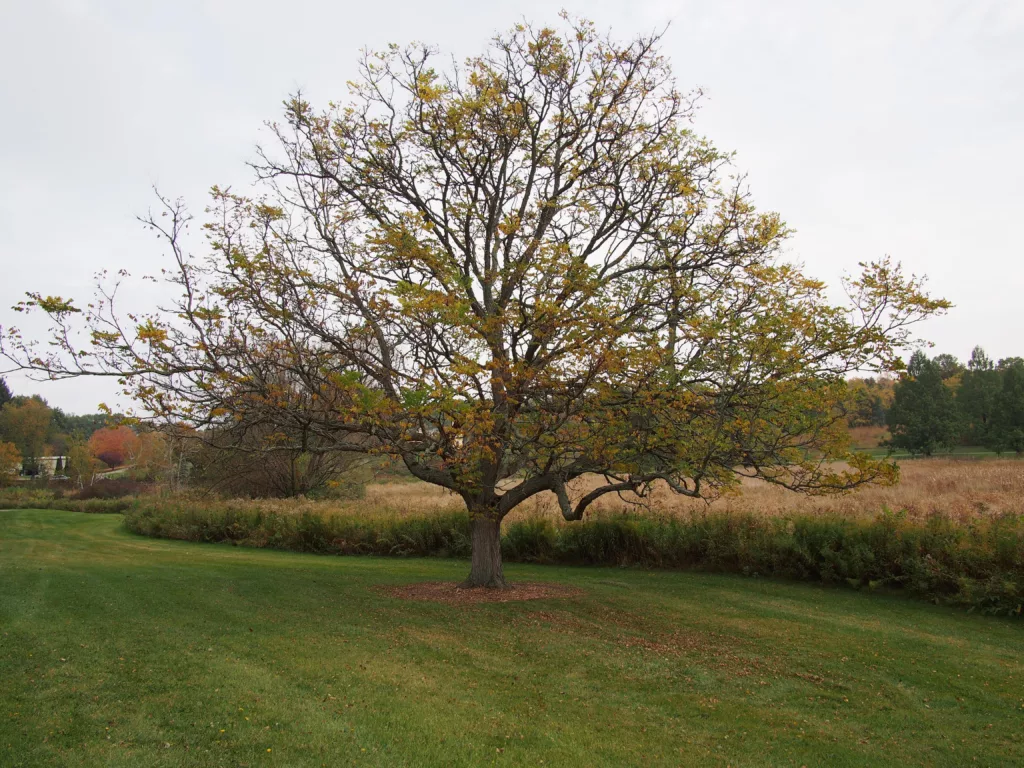
Grow zones 3-8
Kentucky coffee trees do produce edible seeds (after roasting) to consume as a coffee substitute, but they aren’t the same as traditional coffee from coffee plants.
Consuming parts from Kentucky Coffee trees comes with caution, so please do your own research if you want this tree because you’re a coffee lover! You may find it is or isn’t the best choice for shade even with this dual purpose.
Kentucky coffee trees are grown for beauty, pollinators, drought tolerance, resilience, low maintenance, and for diffuse shade.
Similar to Northern Catalpa, this tree is an option for good looks with the bonus of diffuse, moderate, or dappled shade. You won’t be scoring dense or full shade from open canopy trees like these.
If you love the look of Kentucky Coffee trees, the best shade-giving varieties with denser canopies include:
- The Espresso Kentucky Coffee tree grows large leaves on a dense and upright canopy.
- The Stately Manor Kentucky Coffee tree grows like a pyramid with symmetrical upright branches creating a dense canopy. This tree is described as elegant.
- The Kentucky Coffee tree named ‘Macho‘ translates to ‘male’ so they don’t produce seed pods as females do. But they form spreading canopies in a short time for plenty of shade.
- The Esperanza Kentucky Coffee tree is a smaller tree that gives good shade in compact spaces.
Most Kentucky Coffee trees are slower to grow than other options in this post, but they live very long, and are resilient to pests and disease, and general stress.
Best Tulip Trees for Giving Shade
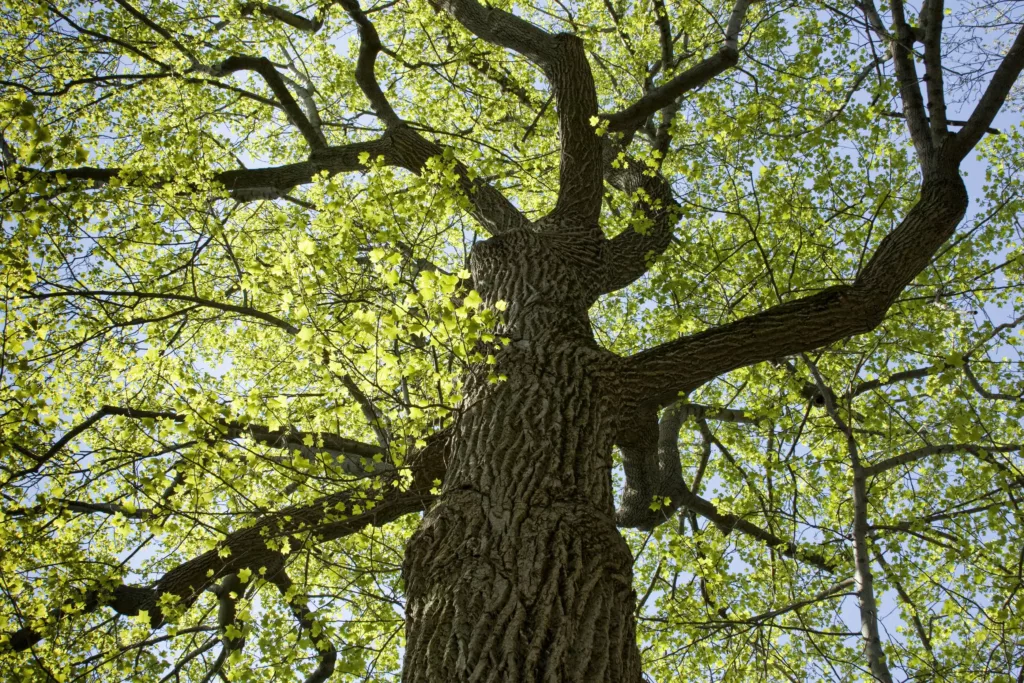
Grow zones 4-9
Tulip trees are generally known to give shade no matter the variety you choose. Other than shade, tulip trees are native to North America and grown for beauty, wildlife habitat, and high-quality wood.
The first time I saw a tulip tree it was in flower. When I discovered its name I was not only shocked but further fascinated to look closer—it had bright orange tulip-like flowers and I loved it. It was along the street of a small town road.
We actually took clippings to grow some for ourselves, but those didn’t make it after being in a hot car for too many hours.
| Tulip Tree Variety | Character | Size | Fall Color | Preferences |
| Fastigiatum | Narrow, upright, tight shape | 60ft H, 15ft W | Yellow | Well-drained, adaptable to clay |
| Arnold | Pyramid to oval shape, dense leaves | 90ft H, 50ft W | Bright yellow | Moist well-drained, adaptable to clay |
| JFS-Oz | Narrow, tight, dense, symmetrical shape | 40ft H, 20ft W | Vibrant yellow | Moist well-drained, tolerant to a range of soils |
| Aureomarginatum | Variegated leaves; green with gold margins | Moist well-drained, tolerant to a range of soils | Yellow to orange to bronze | Well-drained and moist, but adaptable |
Conclusion
All of these trees have ornamental value!
The best beauty is in the eye of the beholder, so consider the type of shade you want, write down your best shade-giving picks from this list, then search for more images of each tree to decide which one you love best.
Up Next: 24 Best Edible Ground Covers for Shade
Recent Posts
There’s no shortage of full-sun ground covers for zone 4 climates! Each plant in this list can withstand the frigid temperatures and also enjoy the hot sun in summer. Full sun means that a plant...
There's no shortage of full sun ground covers, not even in zone 3! Zone 3 climates offer hot but short-lived summers and very cold winters. So each plant in this list can withstand the frigid...
